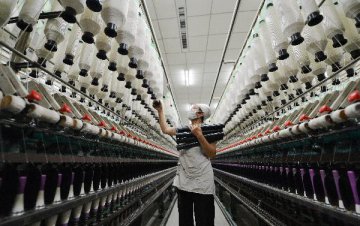
16 representatives from the nations participating in the negotiation on Regional Comprehensive Economic Partnership (RCEP) held a meeting in South Korea on Oct. 12. The participants revealed that RCEP has entered into a crucial stage, with such negotiation substantially finished before the end of this year.
The RCEP covers 16 countries, such as 10 nations of ASEAN as a main body, China, Japan, South Korea, India, Australia and New Zealand, involving a population of 3.4 billion people. And seven nations, including Australia, New Zealand, Japan, Malaysia, Singapore, Viet Nam and Brunei, are also the members of Trans-Pacific Partnership Agreement (TPP).
A Korean officer familiar with inside information of RCEP negotiation said that 16 nations will propose a tariff reduction list related to commodity and labor service, hoping to make every effort to reach an agreement before the end of this year. Another Indian officer pointed out: “Member states are all pressed to accelerate the negotiation.” Mustapa, minister of Ministry of International Trade and Industry of Malaysia, said to the media a few days ago that they will make every effort to finish a substantial negotiation before the end of this year.
It is learnt that all parties in the negotiation have already reached an agreement on price-offering mode for the visible trade, will try their best to end the substantial negotiation before the end of this year and solve other technical problems as soon as possible within 2016. RCEP covers over a half of the global population, with economic and trade scale accounting for 30 percent of the world scale.
Gao Hucheng, minister of Ministry of Commerce of PRC, once indicated earlier that RCEP will cover a free trade zone with largest population, most diversified members, most different levels in economic developments and most powerful vigor. RCEP involves seven TPP members, with high transparency, openness and inclusiveness as its distinct features.
In terms of possible favorable factors produced by RCEP for ASEAN, the main participant, an article of the Asia Foundation, a non-profit, non-governmental organization, pointed out ASEAN plays a crucial role as a functional center under the RCEP framework, which is very obvious. ASEAN can protect its interest better through the central position in RCEP negotiation, with a purpose to make the RCEP adopt a practical access permission mechanism of low threshold, so that ASEAN can enhance its economic integration progress in RCEP to make every effort for maintaining the unity of its member states.
However, imbalanced developments in ASEAN members also become a challenge in RCEP negotiation. GDP per capita of Malaysia and Singapore exceeds 10,000 US dollars, while Burma, Cambodia and Laos are still working on problems of food and clothing for the public. How to balance interests of all parties also becomes a key point in the negotiation.
As a free trade agreement including countries with different development stages, cultural backgrounds and population size, RCEP will have great significance to economic development, employment and multi-lateral investment in the region once it come to an agreement. Moreover, RCEP also contribute to the construction of a peaceful, safe and developed Asia Pacific region, exerting significant influence to the Asia-Pacific and the world.
Another external factor accelerating RECP negotiation is Trans-Pacific Partnership Agreement (TPP) dominated by the US has been reached on 5 Oct., which means the economic and trading landscape of Asia Pacific region will be affected.
Official from the Ministry of Foreign Affair of Japan said that the conclusion of TPP negation will speed up the process of RECP negotiation, and may make “the result of the negotiation come to a higher level”. New Zealand Ministry of Foreign Affairs and Trade spokesperson said: “New Zealand regards TPP and RCEP as complementary pathways towards FTAAP”.
“China will continue to adhere to the spirit of mutual trust, tolerant, cooperation and mutual winning, and work together with nations in the region to push forward free trade arrangements within the area. At the same time, we hope TPP and RECP could complement and facilitate each other, benefit the multilateral trading system and contribute to the long-term prosperity and development of Asia Pacific region ”, Foreign Ministry spokesperson Hua Chunying told a regular press briefing.
Analysis pointed out that RCEP, which is still under discussion, is more ‘grounded’. Unlike the US dominated TPP characterized by high standards, RECP, which joined by China, Japan, South Korea, India, New Zealand and Australia, is more compatible with the situation that such Asian countries are in different stages of economic development.
Regional FTA agreement negotiations have become increasingly prevalent. It has provided a new way for Asian countries in economic woe to drive economy growth. China’s free trade area construction is also pressing ahead. So far, china has 19 free trade areas under construction, involving 32 countries and regions. China has signed 14 free trade agreements related to 22 countries and regions, including agreements exercised between China and ASEN, Singapore, Pakistan, New Zealand, Chile, Peru, Costa Rica, Ice Land, Switzerland, South Korea and Australia, Closer Economic Partnership Arrangement (CEPA) between China, Hong Kong and Macau, and Economic Cooperation Framework Agreement (ECFA) between China and Taiwan. All Free trade agreements are implemented, except those signed with South Korea and Australia.
Translated by Jelly Yi and Adam Zhang






















Latest comments